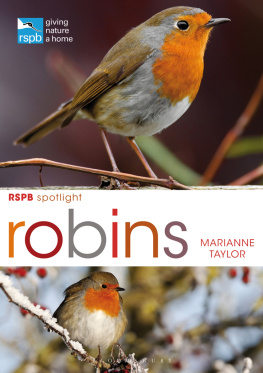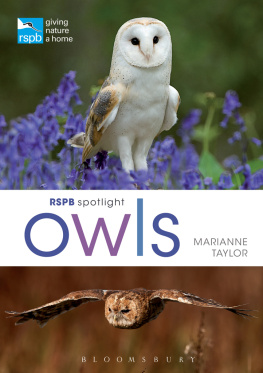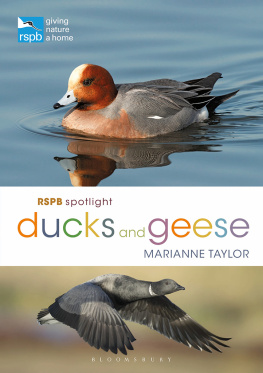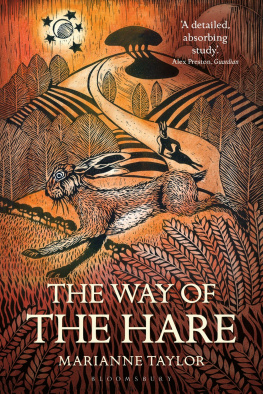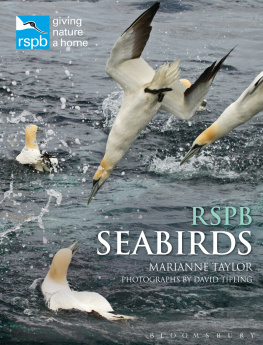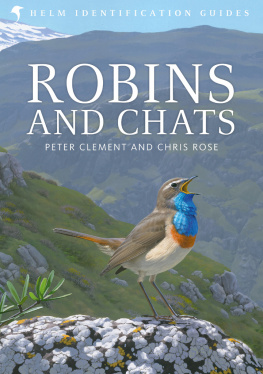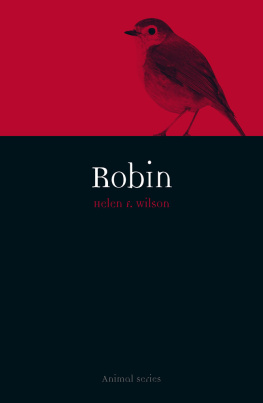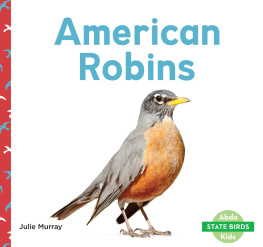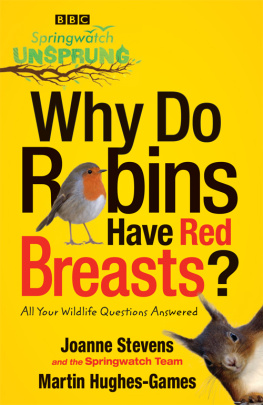

The RSPB is the countrys largest nature conservation charity, inspiring everyone to give nature a home so that birds and wildlife can thrive again.
By buying this book you are helping to fund The RSPBs conservation work.
If you would like to know more about The RSPB, visit the website at www.rspb.org.uk or write to: The RSPB, The Lodge, Sandy, Bedfordshire, SG19 2DL; 01767 680551.
Bloomsbury Natural History
An imprint of Bloomsbury Publishing Plc
| 50 Bedford Square | 1385 Broadway |
| London | New York |
| WC1B 3DP | NY 10018 |
| UK | USA |
www.bloomsbury.com
Bloomsbury is a trademark of Bloomsbury Publishing plc
This electronic edition published in 2015 by Bloomsbury Publishing Plc
First published 2015
Marianne Taylor, 2015
Photographs and Illustrations as credited , 2015
Marianne Taylor has asserted her right under the Copyright, Designs and Patents Act, 1988, to be identified as Author of this work.
All rights reserved
You may not copy, distribute, transmit, reproduce or otherwise make available this publication (or any part of it) in any form, or by any means (including without limitation electronic, digital, optical, mechanical, photocopying, printing, recording or otherwise), without the prior written permission of the publisher. Any person who does any unauthorised act in relation to this publication may be liable to criminal prosecution and civil claims for damages.
No responsibility for loss caused to any individual or organization acting on or refraining from action as a result of the material in this publication can be accepted by Bloomsbury or the author.
British Library Cataloging-in-Publication Data
A catalogue record for this book is available from the British Library.
Library of Congress Cataloguing-in-Publication data has been applied for.
ISBN: PB: 978-1-4729-1211-4
ePDF: 978-1-4729-2266-3
ePub: 978-1-4729-1212-1
To find out more about our authors and books visit www.bloomsbury.com. Here you will find extracts, author interviews, details of forthcoming events and the option to sign up for our newsletters.
Contents
Meet the Robin
If you are somewhere in the British Isles as you read this, the chances are that there is a Robin not far away from you right now. If it is daylight (and even if it is not, and the street lighting is on instead), you might well be able to hear one singing. Should you be near a garden you could well spot another busily foraging at the edge of the lawn. This unmistakable little character is probably our most familiar bird species, as well as one of our most beloved.

No British garden is complete without its resident Robin.
We know the Robin best as a garden and parkland bird, and it certainly thrives in those places. However, before people came along to create parks and gardens it was a bird of forest, woodland, scrubby ground and other well-vegetated habitats, and it is still common in such habitats today. It has one of the widest distributions of any British bird, occurring throughout Britain and Ireland, including most offshore island groups. It is most numerous south of Yorkshire and Lancashire, but its range extends to the far north of Scotland, and it is only missing from the highest and barest mountains and uplands. There are nearly eight million breeding pairs across the British Isles (6.7 million of them in the UK), making the Robin our second most numerous breeding bird species (the Wren holds the top spot).

Its habit of perching on raised objects to survey the scene is an endearing Robin trait.
On mainland Europe the Robin (or European Robin, to give it its full name) is a more secretive bird in most areas than it is in the British Isles. Only in northern France does it have a similar prominence in folklore and legend. Most European countries are also less densely Robin-populated, with the huge landmasses of Poland, Spain and Finland, for example, holding about 1.5 million, 3 million and 3.3 million pairs respectively. However, the Robin does occur across nearly the whole of Europe, parts of North Africa, and a sizeable chunk of western Russia. BirdLife International estimates its total world population across this extensive range to be somewhere between 137 million and 332 million individuals.
In less enlightened times settlers from the British Isles often brought wild birds from their homeland to new lands, hoping that their presence would make things seem a bit more homely. Attempts were made to introduce Robins to Australia and North America, but no viable populations were established. This is in contrast to the House Sparrow and Starling, which are both now extremely numerous in both areas, to the detriment of native birds.

A French Robin. In much of Europe, the closely related Black Redstart is a much more familiar garden bird.
National treasure

Although Robins have a wide Eurasian distribution, only in the British Isles are they ubiquitous garden birds.
Unlike most nations, the United Kingdom has no official, government-endorsed national bird. However, when The Times newspaper polled its readers in 1960 to select an unofficial one, three front-runners soon emerged the Red Grouse, Wren and Robin.
The Wren is probably Britains most widespread bird, and perhaps deserved the title for that alone; it is also a familiar and much-loved garden bird with tremendous charm and energy wrapped up in a pint-sized package. The Red Grouse had perhaps an even more legitimate claim to the title at the time, not because of the Glorious Twelfth, the start of the shooting season for Red Grouse, but because it was the only species in the world to occur nowhere else (the vagaries of taxonomy have since revised its status to a mere subspecies of the continental Willow Grouse).
The Robin is found across a wide swathe of the European and western Asian mainland beyond the British Isles, but it has a particularly close connection with British cultural tradition, and its confident nature, sweet song, pretty plumage and perky demeanour have thoroughly endeared it to successive generations of Britons. The Robin won the vote by a landslide, beating the Red Grouse and Wren into second and third place respectively.

The Red Grouse, like the Robin, is another British favourite bird, though for rather different reasons.
Vital statistics

